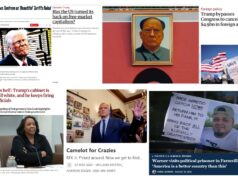Appearing in several newspapers in VA-06, this series announced itself as having no partisan agenda, no pre-conceived conclusion, but just the purpose of laying out as clearly as possible what the questions are that need to be asked if the United States is to find its way through this dangerous crisis involving North Korea and the threat from its nuclear weapons.
*************************
This is the third and final installment in a series whose purpose is to provide clarification of the issues that American decision-makers must think through in deciding how to deal with the crisis with North Korea.
In the second installment, the question was asked: Which is worse—letting North Korea gain the ability to strike the U.S. with nukes, or attacking them to destroy that threat (and likely the regime itself) before that point is reached?
And that part reached the conclusion that judging just how dangerous it would be for the North Koreans to become a full-fledged nuclear power is of central importance– because a war to stop that from happening would likely be horrendous.
How Costly Would a Pre-Emptive War Against North Korea Be?
As former Defense Secretary Leon Panetta said last week, “There’s a reason no president in recent history has pulled the trigger on North Korea.” Whenever the Pentagon has gamed out possible war on the Korean peninsula, the conclusion has been that the costs would be staggering.
Even without nuclear weapons, the scenarios always recognize that well-dug-in North Korean artillery could substantially destroy South Korea’s capital city, Seoul. A mere 35 miles from the DMZ (formed to separate the two Koreas at the end of the Korean War in 1953), Seoul has in its metropolitan area a population of some 25 million people. (Also within range of such artillery fire are many of the 28,000 American troops stationed in South Korea.) The casualties would be horrific.
And that’s just the beginning.
It is said that the North Korean nuclear program is invulnerable to any conventional weapons attack from the air. To destroy that program would require either 1) that the U.S. use nuclear weapons in war (for the first time since Hiroshima and Nagasaki) to destroy underground facilities; or 2) that it fight another “land war in Asia,” against which General Douglas MacArthur warned so many years ago.
Wars are always more easily begun than ended. How things will unfold is unpredictable and usually, it seems, they go worse than the planners expected.
I’d ask the experts:
“What would you expect American casualties would be in the event of such a war? And what would be the costs to the South Koreans?
“Would the North Koreans be able to use any of their nuclear weapons against us or any of our allies in the region (South Korea or Japan), with our without resort to missiles to deliver them?
“What would happen to North Korea and its people?
“Might an American attack on North Korea bring major powers into conflict?
“And what are the likely consequences to the international order of the United States launching such a pre-emptive war?”
It may be that the United States is compelled to choose between these two terrible courses of (in)action: either letting the North Koreans gain the ability to launch a nuclear attack on us, and hoping they don’t; or going to war to pre-emptively destroy that threat, and accept a virtually inevitable enormous loss of life.
Three American presidents have been glad that this choice did not need to be made under their watch.
Is President Trump Playing His Cards Wisely?
In that imaginary discussion with the experts with which I framed this inquiry, I’d want to know what they think about the means by which President Trump is apparently bringing this crisis with North Korea – brewing now since at least 1994 – to a head.
More than any of his predecessors, President Trump has turned to the use of threat to deal with this problem.
If the threat can 1) get the North Koreans to change course, or if it can 2) get the Chinese to get the North Koreans to change course, Trump’s approach would be vindicated. Even if it’s a bluff, it would have proved useful.
But if the North Koreans cannot be intimidated, and if the Chinese either won’t or can’t get the North Koreans back down, then Trump must either make good on his threat or back down. That’s the trouble with bluffing.
For a bluffer, it is essential that his bluff not be called. Threats are an important tool. Their value depends upon their being believed. And they should be used with care, unless one is glad to follow through on them.
If the armada is intended not as a bluff but as a preparation for an actual attack, I’d ask the military experts: is this a good way to begin such preparation?
If the threat is a bluff, has it been posed carefully enough?
(Better that the ostensible trigger be vague enough that the emptiness of the threat is not readily exposed. For example, NBC reported last week that the United States might launch a pre-emptive attack if the North Koreans went ahead with a sixth test of a nuclear bomb. Pinning the threat to such a definite trigger – something that could have happened last weekend, and still may happen in the coming weeks – makes it too easy for a resolute opponent to show the threat to be hollow.)
Having one’s bluff called debases the value of all future threats. Threats well used help prevent war. Threats not believed increase the chances of war.
This is a dangerous moment. One can only hope that President Trump and his advisors (like his generals, National Security Advisor McMasters and Defense Secretary Maddis) are asking the right questions, getting good answers, and thinking through their strategy with the care that the whole world needs from its greatest military power.
************************
In the 1980s, Andy Schmookler was tasked with distilling the views of foreign policy experts at the Center for Strategic and International Affairs (CSIS) in Washington, and interviewed experts for a project at the Public Agenda Foundation about how to find security in an age of nuclear weapons. In the 1990s, he was hired by the U.S. Army to help think through some particular issues concerning weapons of mass destruction. Dr. Schmookler is also the author of The Parable of the Tribes: The Problem of Power in Social Evolution.














